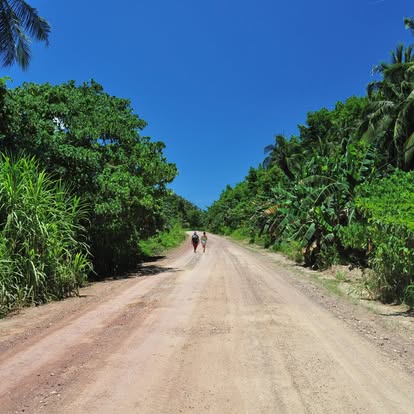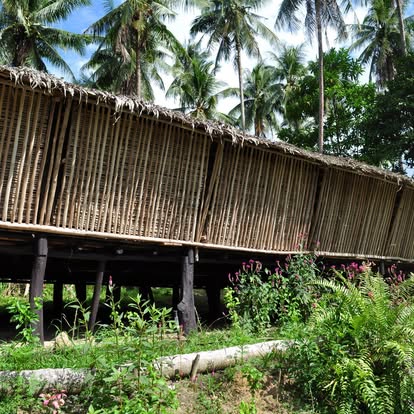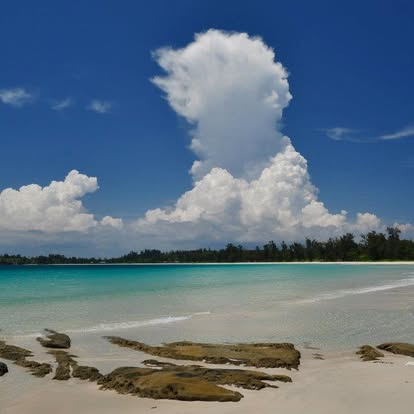Borneo: Between Paradise and Reality
(A traveller’s kitchen table recollection)

Arrival in Kota Kinabalu
We arrived in Sabah with great expectations — visions of a tropical paradise where jungles spill into white beaches, where spicy seafood and easy smiles greet you at every corner.
Leaving the terminal and stepping into the heat, it hit us — this is it. Kota Kinabalu. The name alone sounded like an adventure. We found an affordable hostel in the tourist quarter, freshened up, and set out to explore.
The first impression wasn’t postcard-perfect. Traffic snarled, exhaust hung heavy, and the air was thick with city fatigue. Faces looked tired. But beneath the noise and the smell was something real — a city alive on its own terms, not built to please visitors. Street stalls lined the footpaths: laksa, Malay satay, Indian curries, Chinese soups, and the inevitable KFC. For anyone who loves food, KK is paradise on a budget. Our first meal — two mains and two sodas — cost just fifteen ringgit. Healthy, small portions and humid heat made overeating nearly impossible.
That night, our “bargain” hostel revealed its price. A karaoke bar beneath our window exploded to life. The walls shook with off-key enthusiasm until exactly midnight, when, mercifully, silence returned.
The Night Market and the Chicken Heart
The next day we met Ben and Jane, fellow Australians, who insisted we visit the night markets. The seafood section was a spectacle — from sardines no bigger than fingernails to tuna the size of a toddler. The prawns were monstrous, like small lobsters. Ben waved us over mid-photo and invited us to join them for dinner.
At the grill, the cook offered, “Chicken liver? Chicken heart? Chicken skin? Chicken neck? Chicken foot?” I went with “chicken meat,” then, feeling adventurous, added one “chicken heart.” It wasn’t until later, mid-bite, that I realised he’d actually said “chicken arse.” When in Rome, right?
Mountains, Mist, and Misadventures

Over dinner we confessed our dilemma: every adventure in Sabah seemed locked behind expensive package tours. Ben and Jane had the same problem but also a plan — rent a tiny car and head for Mount Kinabalu and the Poring hot springs. They invited us along.
Our rented 600-cc white hatchback looked more like a sewing machine than a car, but it purred like a champion. We left late, detoured often, but eventually reached the rainforest canopy walk — suspended bridges swinging through treetops dripping with mist. It was everything we’d hoped for.
By the time we began the drive back, the mountain was swallowed in fog. The road vanished. We crawled forward until visibility dropped to zero, then pulled over. When a truck passed, we tailed its red lights like breadcrumbs out of the cloud. Soon rain joined the darkness. We powered through flooded roads, got lost, filled the tank by mistake, argued with a mischievous petrol attendant, and crossed a swollen river before finally rolling into town at 10:30 pm — soaked, exhausted, laughing.
Escape to the Northern Tip

By Monday we’d had enough of karaoke and concrete. We booked flights to Sarawak but had nine days to kill in Sabah. Stacy remembered reading about an eco-lodge at the northern tip of Borneo. It wasn’t finished yet, but when we called, the owner invited us anyway. Anything to escape the city.
At the Kudat bus stop, we met Tess, another Aussie traveller. By the time we arrived, she was part of our crew. A green, rust-scarred Land Rover pulled up, driven by Howard — an English expat with a wild beard and an empire in progress. His volunteer, Scott, rode shotgun. We tossed our backpacks into the tray and bounced down coconut-lined tracks toward the jungle.
When we reached the longhouse — a sprawling bamboo and coconut-wood home under construction — we knew we’d found what we were searching for.
Life in the Longhouse

The longhouse stood like something out of an anthropologist’s sketchbook: open-sided, breezy, smelling of timber and rain. Howard only employed locals and sourced all materials from nearby villages. His respect for the Rungus people was obvious.
At the beachside restaurant, we met Steph (Scott’s partner) and Toby, both English volunteers. Locals crowded around, laughing, drinking beers, eager to practise English. Their warmth was disarming, their hospitality unfiltered.
That night, we fell asleep to the rustle of the jungle and the hum of distant waves.
Howard, the Gypsy Crew, and the Path of Asphalt

By the third day, I was restless. I offered to help with the project, and Howard accepted immediately. The next morning he hauled Scott and me into town for errands — which in Howard’s world meant fourteen unrelated stops involving scrap metal, road tar, and an impromptu meeting about a Finnish family’s trek.
By afternoon, we were shovelling chunks of discarded asphalt into the back of the Land Rover, sweat pouring, laughter constant. We built a path to the shower block and, by sunset, rewarded ourselves with beers and a swim. The sea glowed orange and pink — a molten mirror.
“We were covered in dirt and sweat, but the sky was pink and purple — I’d never felt happier.”
Coral, Culture, and the Sunset Swim

Saturday brought new stories. Howard was off negotiating a dowry for his fiancée with her village elders — ten thousand ringgit, an old car, and future divorce clauses that could bankrupt a man.
Meanwhile, we joined the locals for snorkelling. The coral was grey and lifeless, bleached of colour — a quiet sadness beneath the beauty. Theories abounded: pollution, sunscreen, the sun itself. Then, calamity — Stacy’s camera crushed under a quad-bike tyre, and I emerged from the sea with a sunburned back. We laughed anyway. Uncle Paul, the quad guide, passed us beers, and we watched the horizon fade to fire.
The People

What stayed with me was the people: the quick laughter, the fearless hospitality, the way a rough plan became a working community. Some places aren’t just visited; they’re absorbed.
Reflections on Sabah
Borneo was never the postcard paradise we’d imagined. It was rougher, louder, more honest — and infinitely more interesting.
Paradise, I’ve learned, isn’t perfection. It’s the moment you stop comparing what is to what you expected. It’s when the fog lifts, the road opens, and you’re laughing in a rusted Land Rover, on your way to nowhere in particular.
From the traveller’s kitchen — Simple Chicken Laksa
Inspired by nights in Kota Kinabalu — simple, spicy, and unapologetically satisfying.
Ingredients
- Drizzle of coconut oil
- 2–3 chicken thigh fillets, thinly sliced
- ⅓ cup (about 100 g) laksa paste — the kind with a label that’s difficult to read because it’s in another language (that’s usually a good sign)
- 2 chicken stock cubes dissolved in 275 ml of water
- 1 cup (250 ml) good-quality coconut milk
- 2 kaffir lime leaves, finely shredded
- 1 tbsp grated palm sugar
- ½ tsp MSG (optional, but authentic)
- 1 tbsp fish sauce
- 1–2 tbsp lime juice (to taste)
- 4 boiled eggs, peeled (optional but ideal)
- 200 g dried vermicelli rice noodles
- 2 cups (160 g) trimmed bean sprouts
- ½ cup Thai basil leaves (if available)
- ½ cup coriander leaves, finely chopped
- Fresh spring onions, sliced
- Sliced red chilli, for garnish
Method
- Heat the coconut oil in a wok or deep pan over medium-high heat. Add the chicken and stir-fry for about 5 minutes until just turning golden. Remove and set aside.
- Add the laksa paste to the same wok and stir-fry for about a minute, until fragrant.
- Return the chicken, then add the stock, coconut milk, lime leaves, and about half a cup of water. Bring to a gentle boil, reduce heat, and simmer for 10 minutes until the chicken is tender.
- Stir in the palm sugar, MSG, fish sauce, and lime juice — adjust to taste. It should hum with salt, spice, and citrus.
- Cook the noodles according to packet instructions, drain, and divide among bowls.
- Ladle over the steaming laksa, then top with bean sprouts, Thai basil, boiled eggs, coriander, spring onions, and a few slices of red chilli.